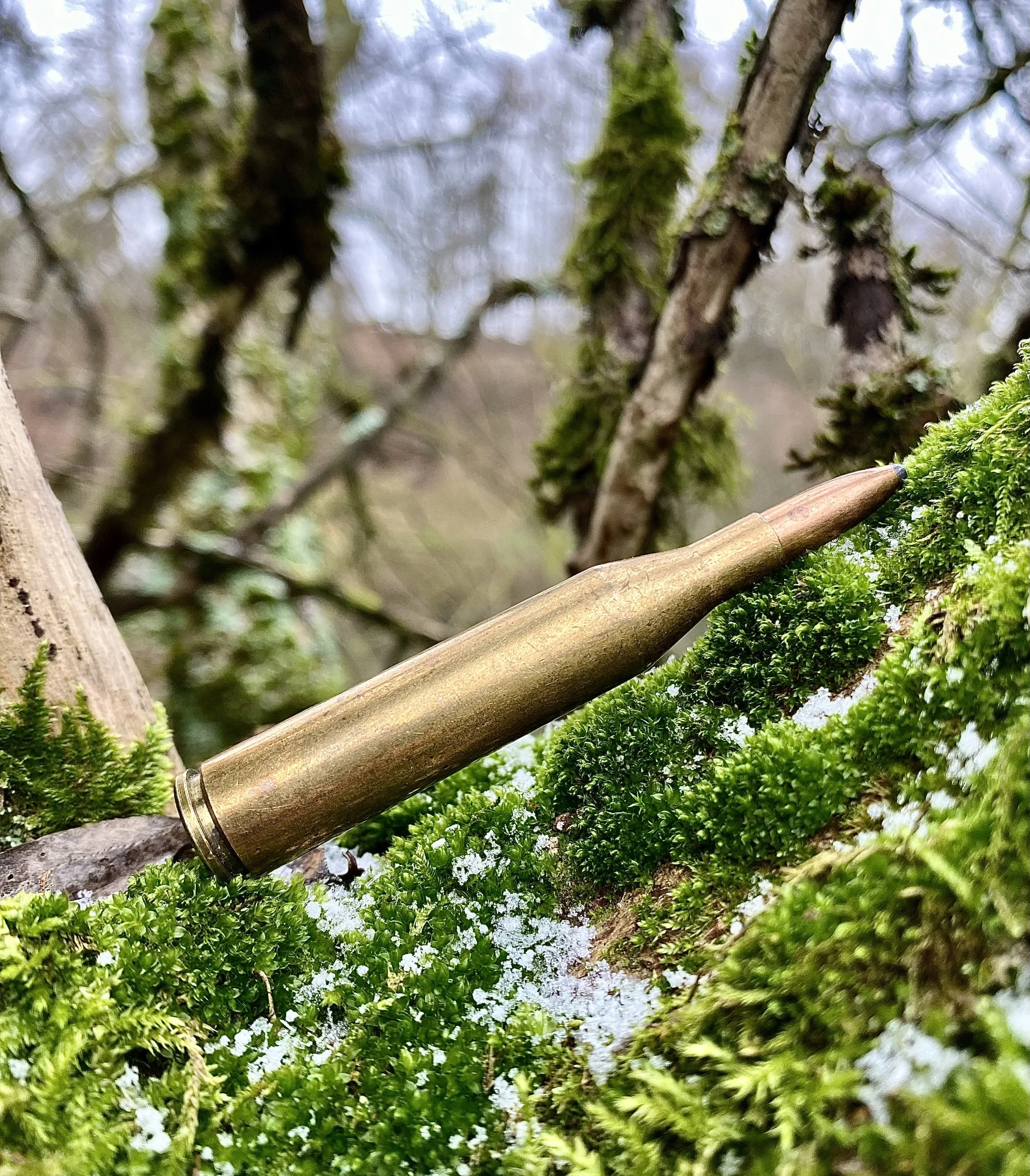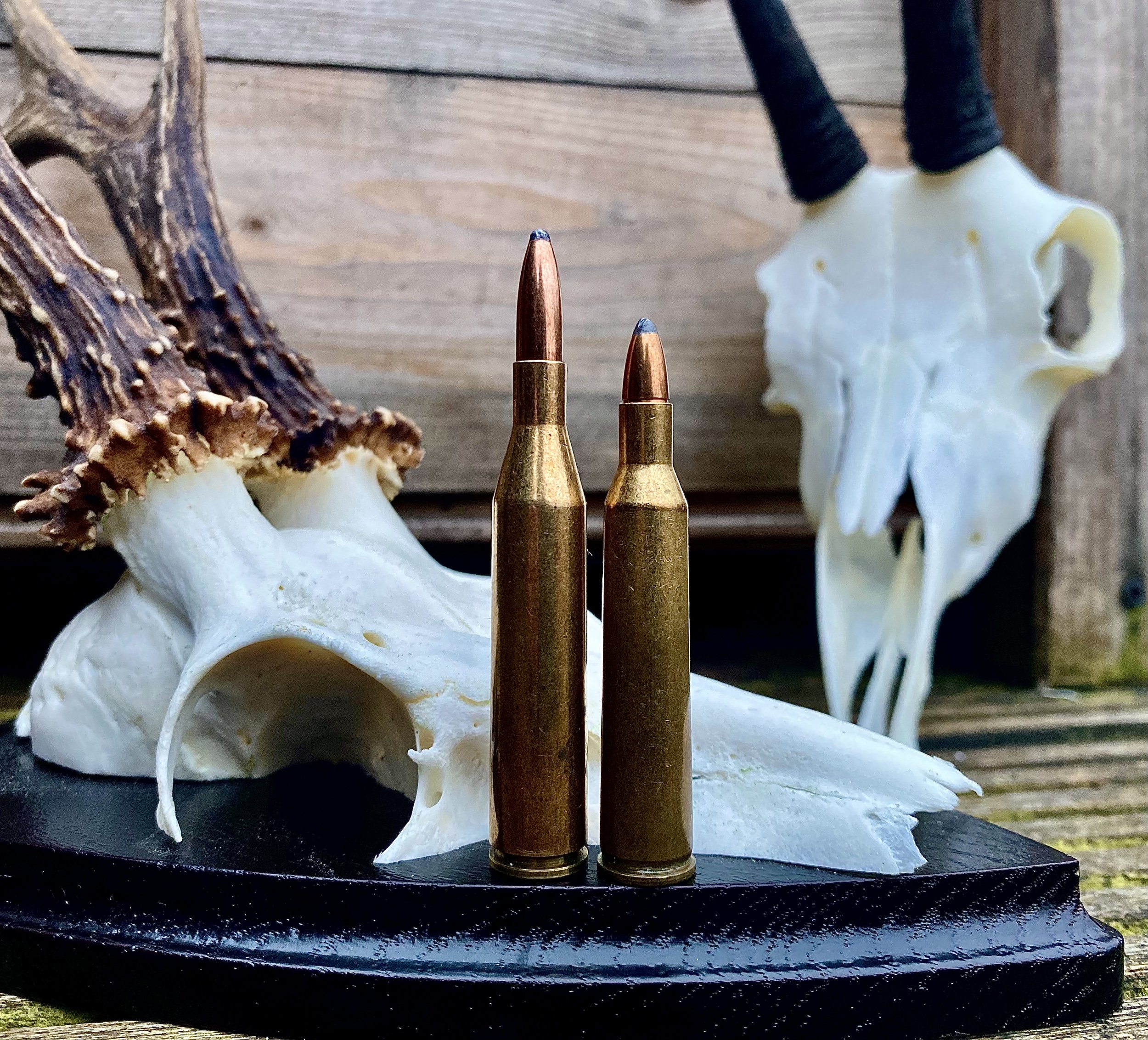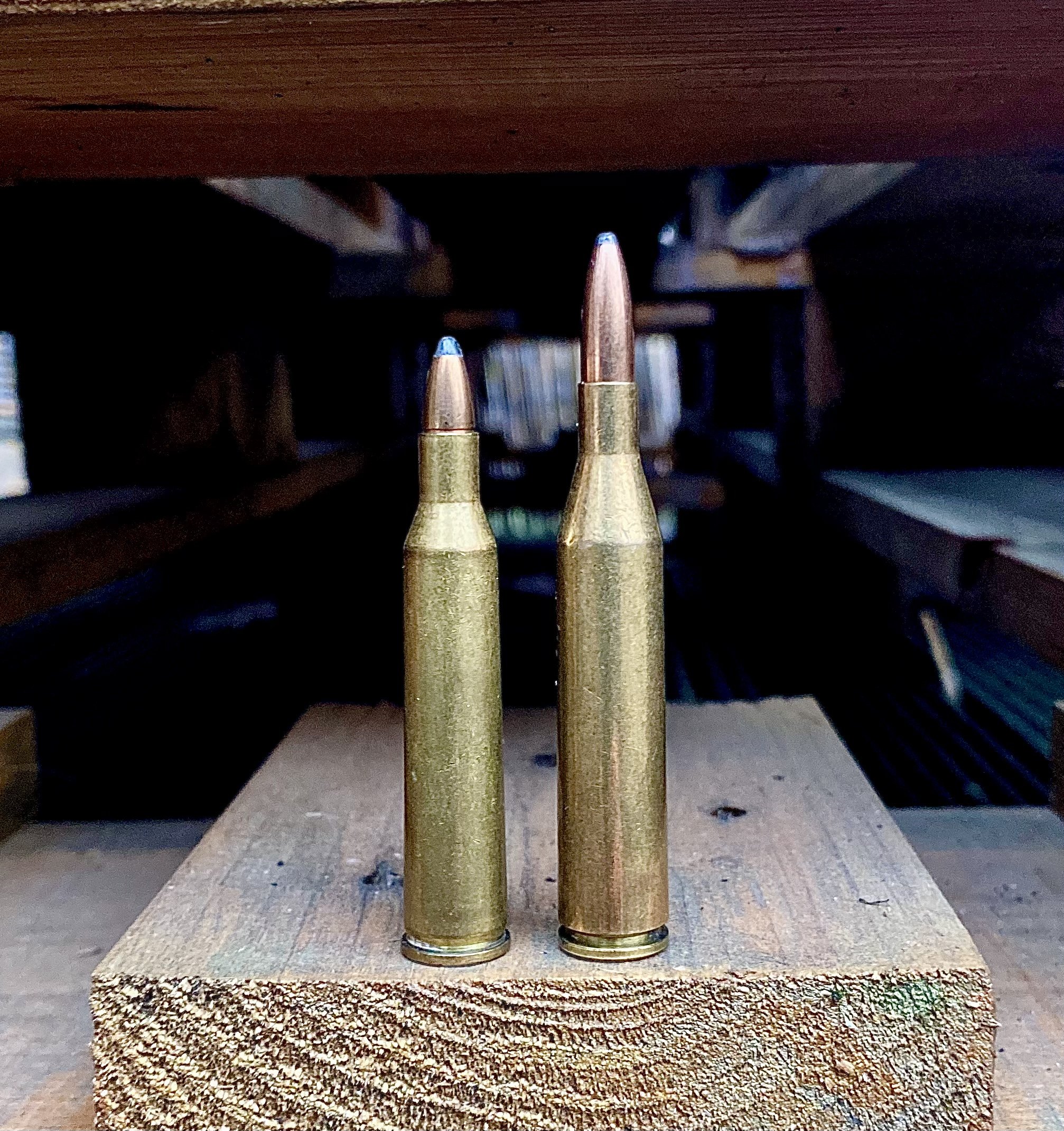A Speedy Oddity
Most .22 caliber bullets actually shoot .224/5.69mm diameter bullets. But two toss the odd .228 caliber bullets. Both emerged in the era before 22-caliber standardized at .224. One is American, the other European, and you may have never seen either.
The .22 Savage Hi-Power of 1912 is a more or less known commodity to American hunters. In Europe, it’s better known under its metric designation, the 5.6x52R. Regardless the name, it’s not a common sight at the range or in the field.
Vom Hofe’s smallest cartridge has a sleek design.
The 5.6x61mm Super Express vom Hofe from Germany is an ever rarer bird. This small bore hit the scene in 1937, maybe 1934, when the Nazi regime reigned in Central Europe. For the sake of its reputation, let me tell you it was a civilian development for hunting use only. Its inventor was the then well known Ernst August vom Hofe. His name is firmly attached to several high power cartridges like the 7x73mm Super Express vom Hofe and others. After vom Hofe died in 1945, Walther Gehmann took over the rights of vom Hofe‘s inventions in the 1950’s, including the name. He himself was an accomplished marksman. Gehmann went on to develop cartridges like the 7x66 and the 9.5x66 SE vom Hofe. But he also kept vom Hofe‘s own inventions alive, often simply by offering factory ammunition.
Why exactly vom Hofe chose the .228 inch diameter of the Hi-Power, I can’t determine. Sometimes just being different is reason enough. Think of the .277 caliber of the .270 Winchester. It really didn’t make any practical sense choosing such a slightly smaller diameter compared to the .284 inch width of the 7mm cartridges. Regardless, Winchester chose it and set a benchmark. Maybe vom Hofe had a similar reasoning. For all we know, had he stuck with what is much more common today, the .224, his cartridge might very well be popular to this day. But he didn’t.
As a parent case, it’s very likely he chose the 6.5x55 Swedish. So there is definitely enough room for propellant to drive the small projectiles fast. Really fast. But we’ll talk about ballistics later. The additional 6mm in case length mostly stem from the prolonged shoulder, a result of necking the parent case down without giving it a steep shoulder. The resulting long shoulder gives the case a rather odd look.
The CIP (this is the European counterpart to the American SAAMI) lists the cartridge with a bullet diameter of 5.79mm, which is not exactly .228 inch. Some sources say .227 inch. But if you convert 5.79 mm to imperial measurements, it’s .22795 inch, so it’s actually closer to .228 inch. As component bullets, you can find both .227 inch and .228 bullets. Either way, I doubt that a smaller diameter of one thousandth of an inch is of concern. If cases grab bullets securley and barrels stabilize and shoot them straight, perfect. Problems with pressures should also not occur if a smaller diameter bullet is launched.
The cartridge saw a somewhat widespread use in its earlier years. It was mainly used to reach out far for smallish roe deer and especially chamois in the European Alps. Its high velocity potential, paired with light weight bullets that sufficed for these fragile game animals, delivered a long Maximum Point Blank Range. That was useful with the small vitall zones of roe and chamois in the days before precision range finders.
Anecdotally, the 5.6x6mm SE was also used on red deer with great success when hunters shot heavier projectiles. I would not recommend the use of a cartridge this small for big critters like red stags. And it’s not legal anymore in many places, anyway. But a well placed bullet between the ribs will certainly do the trick, even on stags. It just leaves no room for error. And erring is human, so I like a bit more mass for reliable penetration on big-bodied animals.
The 5.6x61 Super Express vom Hofe (left) in front of the intended game, roe deer and chamois. A .220 Swift for comparison.
The cartridge would shine as a top choice for light North American game such as coyotes, pronghorn or Coue’s deer. With lighter bullets it’d serve as a rodent round, as well. Just don’t expect a lot of barrel life. That’s a lot of powder to burn in a tiny bore. That’s even more true for high volume shoots over a prairie dog town, where most shooters haven’t the patience to pause to let barrels cool. For everything heavier, I judge this 22-caliber vom Hofe Super Express to be a fringe option at best.
Africa holds a huge variety of game animals. From small predators like caracals and jackals to small plains game like duiker or steenbuck. For these and even warthogs, the 5.6x61mm is a sensible choice. Heavy caliber bullets will properly take down game up to the size of bushbuck or reedbuck. Shot distances can be far in some places in Africa, "far" meaning 300-, rarely 400-yards. The long MPBR comes in handy then. For longer pokes, .228 bullets of the right form can minimize wind deflection, too.
The headstamp of the smallest vom Hofe cartridge.
No rifle manufacturer offers a modern rifle chambered in 5.6x61 SE vom Hofe. Used guns, mostly Mauser 98 variants or Mauser Model 66 rifles, can often be obtained for little money. A new barrel will complement a 98-action in good condition. Other than that, a custom or semi-custom solution is the only option.
Ammunition wise, it’s a tough choice to justify. The 5.6mm SE is a handloader’s cartridge only. There are no factory ammunition choices today. But that’s not the actual problem. That .228 bullet diameter is. Only a few manufacturers sell bullets, and most are simple cup and core projectiles of 71 grains (4.6g). Lighter fragmentation bullets made from brass, along with very few small company controlled expansion bullets from copper exist. A bullet much heavier could be launched from a case this big. That would turn this German cartridge into a viable deer round. But, until some manufacturer steps up and produces a heavy, controlled expansion .228 bullet, the cartridge is limited. A fast twist rate becomes important with added bullet length. The cartridge is also said to be a bit finicky. When it’s all said and done, you’ll find more than one reason against experimenting with the small vom Hofe cartridge. At least from a practical standpoint.
Cases on the other hand are not a problem. At least two manufacturers in Germany sell brass for the cartridge. Handloading manuals and websites offer insight in powder and primer selection. Except for diverse bullets to choose from, everything is there to get going. In the end, the 5.6x61 Super Express is not a convenient cartridge to use, even if you roll your own.
Because so many European rifles are break action, rimmed cartridges are needed. No surprise, the 5.6x61 comes as a rimmed version. As you might imagine, the 5.6x61mmR Super Express vom Hofe is even more obscure than its rimless cousin. With similar ballistics, it is perfect for light mountain rifle, yet I have never seen a rifle offered in this chambering. This version is practically dead, while the rimless one clings to life.
Take a look at the ballistic table of one of Gehmann‘s loads from the middle of the 20th century and you’ll see that this is a potent cartridge.. You should take that data with a grain of salt since European ammo companies used unreasonably long test barrels to increase advertised ballistics back in the day. Still, it is a fast round. Unfortunately, I couldn’t find a trustworthy BC-number for the 5g "paraboloid-bullet" of Gehmann’s load, so calculating velocity, energy and drop can’t accurately be done. But I want to give you the data of the ammo boxes as an indicator for the performance level nonetheless. The load used the 5g (roughly 77 grains) lead-core bullet at an advertised muzzle velocity of 3,478 fps. The zero was 215m, about 235 yards.
That is some serious output, even by today's standards. The numbers are not that jaw-dropping compared to other .22‘s, but reaching the speed with a 5g bullet in the 30’s is impressive. Granted, maximum velocity is not synonymous with highest accuracy. Not to mention efficacy and barrel life. But it’s good for reach without worrying about trajectory, less drift for any given bullet, and also for impact energy. Remember, kinetic energy depends on velocity more than projectile mass.
The next table shows the ballistics of an exemplary handload with a lighter 63-grain AERO-SB bullet. This monolithic copper bullet from Austrian manufacturer Styria Arms has a .255 BC. Since no small bore cartridge offers true long range shooting characteristics, I’ll give ballistics out to 400 yards. Beyond that, you’re better equipped with a 6mm/.243 or a 6.5mm/.264 cartridge. This load burns Vihtavuori N555 powder to push the bullet to a muzzle velocity of 3,852 fps from 23.6 inch barrels.
As you can see, we’re talking about a potent small bore here. If nothing else, it’s impressive to see what the old oddball can do. Back in the first half of the last century, few cartridges matched the flat shooting characteristics of this small vom Hofe round.
The 5.6x61 Super Express (right) next to the .220 Swift.
Looking at all the facts, it’s obvious the 5.6x61 SE vom Hofe is not what you should choose, but what you could choose if you’re fascinated by old cartridges. To this day it has a small but fervent following. Its fans know what the smallest vom Hofe cartridge is capable of, and they live with its downsides. The challenge of keeping their guns shooting for them is a pro, not a con. Do you feel the same?







